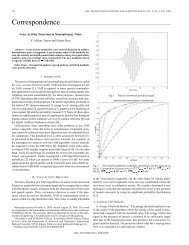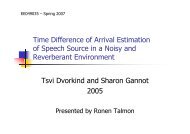Thesis (PDF) - Signal & Image Processing Lab
Thesis (PDF) - Signal & Image Processing Lab
Thesis (PDF) - Signal & Image Processing Lab
Create successful ePaper yourself
Turn your PDF publications into a flip-book with our unique Google optimized e-Paper software.
100 CHAPTER 6. EXTREMA-WATERSHED TREE EXAMPLE<br />
Method used Recognition result Quality coeff.<br />
<strong>Image</strong> without noise, without pre-processing 70-587-07 3.75<br />
Noisy image, without pre-processing 20-687-07 3.47<br />
Averaging filter 70-587-02 3.65<br />
Median filter 70-587-07 3.75<br />
Regular open by reconstruct 79-687-07 3.65<br />
Regular quasi dual open by reconstruct 70-587-07 3.79<br />
EWT filter 70-587-07 3.84<br />
Table 6.1: OCR results comparison with different pre-processing methods.<br />
the pre-processing is applied, the quality coefficient increases and correct recognition<br />
is achieved. Sometimes OCR results are even better for pre-processed noisy image,<br />
than for not noisy image.<br />
In order to measure the effectiveness of the proposed approach, a number of other<br />
pre-processing filters were used. A simple averaging filter, using the same structuring<br />
element was used to filter the image. The result is shown in Fig. 6.33. As can be seen<br />
in Table 6.1, this particular pre-processing gives a very poor result. A median filter<br />
with the same structuring element, which is shown in Fig. 6.34, gives better results<br />
than averaging. Opening-by-reconstruction results, using regular gray scale image<br />
morphology, are shown in Fig. 6.35. The image looks much better, although it is<br />
apparent that the filter is not self dual. The OCR, as seen in Table 6.1, successfully<br />
recognizes the plate number and the quality coefficient goes higher. In order to<br />
handle the lack of duality of regular morphology, we took the following approach:<br />
Two opening by reconstruction operations were performed using the scheme shown<br />
in equation 6.4.<br />
Iquasi−self−dual = 256 − OR(256 − OR(Ioriginal)) (6.4)<br />
Where OR is opening by reconstruction operator, 256 is the maximum gray level and<br />
Ioriginal is the input image.<br />
The filter result is shown in Fig. 6.36. The result looks fine but is a bit more<br />
corrupted than the EWT filtering result in Fig. 6.32. The OCR results, shown in<br />
Table 6.1, are slightly worst than the EWT filtering.
















